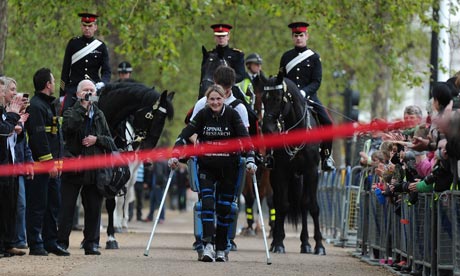 |
| Ironman Official Poster/ Marvel |
 |
| Claire Lomas/ Guadian |
Through development of technology and science, people look forward to emerging robotic technology for human life. Among various kinds of robots, this posting will cover the exoskeleton robot.
What is the exoskeleton robot? You can easily imagine the bionic suit of ‘Iron Man.’ In this film, Tony Stark fights against villains with his exoskeleton robot (its appearance is fancier than the Batman’s whole black suit).
The concept of the exoskeleton robot is not new to us. According to the ‘Popular Science’ megazine, the first concept of the exoskeleton robot appeared in 1890. It was the mechanical suit designed to help the patients to walk. Yet the first scientific approach started at the year of 1963. In 1966, General Electric visualized the exoskeleton robot, called Hardiman. However, it was merely a figurative sculpture due to the limitation of scientific technology at that time.
 |
| Hardiman/ Popular Science |
Current researches of the exoskeletons are mainly focusing on medical assist. Recent famous cases of commercialized robots are ‘HAL-5’ of Japan and ‘Rewalk’ of Israel.
The use of each exoskeleton robot varies. Researchers keep developing and trying to commercialize the exoskeleton robots.
Military
HULC
 |
| HULC/Lockheed Martin |
 |
| XOS2/Raytheon |
The XOS was originally designed and developed by Sarcos for military purposes. After Raytheon took over the company, they announced the developed version XOS2 in 2007. The XOS2 easily carries 200lb cargo over long distances. ‘Time’ introduced such outstanding performances of XOS2. Raytheon is planning to build the complete commercialized XOS2 by 2015.
Medical Assist
 |
HAL5
HAL-5 (Hybrid Assisted Limb) is a robot created by Cyberdyne Company in Japan. It can supplement and reinforce one’s physical capability. HAL catches biosignals of the user through a sensor attached on his or her skin. Based on those signals, the power unit is moves its joint in harmony with the wearer’s muscle movement.
Rewalk
Rewalk is a commercialized walking assist robot by Argo Medical Technologies in Israel. It helps people who are paralyzed from the waist down to move without help. It enables patients to walk, sit-down and stand, and climb up the stairs.
Industrial Use
 |
| Walking Asisst Robot/Honda |
Honda’s Robot
This is the walking assist device created based on Honda Asimo’s robotic technology. The device is designed to reduce the strain of walking. It improves worker’s job performance by strengthening the muscular strength.
The Future of Exoskeleton Robot
The exoskeleton robot is receiving attention as an alternative way of artificial intelligence. Do you think the exoskeleton robot will replace artificial intelligence? Can you imagine bionic people around us? I mean, people like Tony Stark walking around us? Can this exoskeletons stretch the limitation of our bodies and imaginations?
* This posting is restructured based on ‘Design Map’ by Korean Intellectual Property Office.



No comments:
Post a Comment